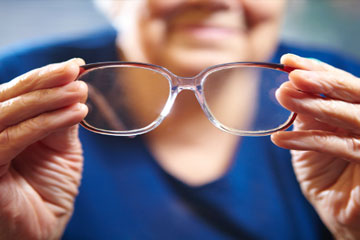Check !! Whether you are candidate for cataract surgery, !! know Important Info before cataract surgery
Cashless Mediclaim Facility | Govt Panel | PSU & Corporate
Restoring Vision, Giving Smile
Patients Treated
Vision to Cataract Patients
Cataract Specialist
Best Cataract Surgery, Surgeon, its Cost & Hospital
Warangal Telangana
A cataract is a cloudy, painless area in the lens of the eyes. It is a result of the protein in the lens of the eye clump. In other words, it interferes with the normal vision of an individual who develops this condition.
Cataract Eye Surgery Cost in Warangal Telangana varies from Rs 10,000 per eye to Rs 70,000 per eye depending upon type of cataract surgery technology, IOL & Cataract Eye Centre. Vision6by6 is a free resource where you can get instant information about the best cataract eye centre in Warangal Telangana. We are helping with our team of best cataract surgeons in Warangal Telangana by counselling & guiding them for selecting the most safe, reliable & lowest rates for cataract procedure. This website is launched with an objective to create greater awareness online about cataract related vision problem & treatment in Warangal Telangana.
Cataract Surgery under Mediclaim – Cashless or Reimbursement
Cataract Surgery in CGHS or in other govt panels such as DGEHS, ECHS, ESI, DDA, MCA, DJB & many more. Cataract surgery is also covered under private insurance companies directly or through TPA. If anyone is covered under such Mediclaim, can scheduled cataract surgery under cashless scheme or reimbursement.
Possible Cataract Treatment
Cataract surgery is one of the most common procedures performed around the world. Millions of people are affected by cloudy and blurry vision that is caused by cataracts that commonly develop with age. Surgery is currently the only way to entirely remove cataracts from the eye. Cataracts are a progressive condition with symptoms that often go unnoticed initially, but they worsen over time.
70+ Cities | 100+ Best Cataract Centre| 500+ Best Cataract Surgeon
Our mission is to create awareness about cataract & its best treatment and to facilitate people with unbiased transparent information about cataract types, cost and best discount one can have with complete trust, transparency and utmost patient care.
Vision6/6 has a dedicated team of cataract counselling experts ensuring very lucid & candid information to patient looking for vision correction cataract surgery with trust, ethics and quality standards in the best interest of patients. Our team also deals with a widespread network of cataract clinics and cataract surgeon for continuous empanelment in our preferred cataract centre in interest of patients. We make sure our patients get best of the treatment for cataract surgery at best discounted rates. Vision6/6 – Center for Lasik & Cataract – Network of Best Lasik & Cataract Centre is always with you in entire journey of Cataract procedure helping society see the world sharper and clearer without glasses
Cataract Technologies & Lenses
Which Cataract Technology : Based on the latest types of Cataract Microsurgical Systems available in market
- Phaco (2.8 mm incision)
- MISC (1.8 mm incision)
- FLACS (Robotic Precision Laser Cataract Surgery) – 1.6 mm & 70% of difficult manual task performed by Robotic Laser
Which Type of IOL (Intraocular Lens) : There are variety of IOL available in market from Indian & Imported with various feature depending upon individual person eyes requirement.
- Monofocoal IOL
- Aspheric IOL
- Toric IOL
- Multifocal IOL
- Trifocal IOL
Cataract Surgery Cost
Vison6/6 – Network of Best Lasik Centres has best team of lasik experts having experience of 20 years in various cataract procedures.
The Cost Of Cataract Surgery In New Delhi May Vary From ₹ 15000 To ₹ 90,000 Rupees For One Eye. The Amount Paid For Cataract Surgery Depends On Several Factors, Including The Type Of Intraocular Lens Implanted In The Eye During The Procedure
Cost of Surgery for Government Panel: All Of The Government Panels Pay For Cataract Surgery With IOL Implantation. However, They Pay For Basic Cataract Surgery With The Most Basic IOL. This Will Provide The Patient With Clearer Vision Post Surgery, The Newer Procedures And IOLs Available Have Improved The Outcomes Of Cataract Surgery. Government Empanelled Persons Can Opt For These Newer Techniques By Paying A Little Extra. The Following Are The Common Government Panels: CGHS DGEHS ECHS MCD FCI CRPF SSB DTC Delhi Police Etc
Cost of Surgery Under Private Insurance : Many People Who Undergo Cataract Surgery In New Delhi Have Private Medical Insurance. Corporate Insurance Is Totally Different From Private Medical Insurance. All The Insurance Companies Pay For Basic Cataract Surgery With Foldable IOL. The Insurance Cover That One Gets Depends On The Insurance Amount. All Insurance are available under cashless services.
Cost of Surgery Under Cash : Patient can walk, get the check up done & book for cataract surgery based upon their budget & medical condition.
Advantages of
Robotic Precision Laser Cataract Surgery
Higher Risk of Complications
Higher Risk of Complications
About Cataract
What is a cataract?
A cataract is an opacification of the natural lens that causes blurry, cloudy, or distorted vision.
The human lens is located just behind the iris, or the colored part of the eye. A healthy lens is
clear and flexible, allowing us to see focused images. As a part of the normal aging process, the proteins in the lens oxidize, which leads to a loss of clarity and hardening. Left untreated, a
cataract can become so dense that it causes blindness and a white appearance to the pupil. In fact, cataracts are the leading cause of blindness in the world. The original meaning of “cataract” is “waterfall,” because the visual distortion of a cataract is similar to the view through a
waterfall. There are multiple types of cataracts, and even within the same type, there are a range of symptoms a person can experience.
Type of Cataract?
People are usually under the misconception that cataract is of one kind only and is solely related to old age. However, this isn’t true. Cataract can be of different types, depending on its cause and which part of the eye it is affecting. Below are the different types of cataract:
Nuclear Cataracts: Forms in the middle of the lens and causes the nucleus (center of the eye) to turn yellow/brown.
Cortical Cataracts: Wedge shaped, forms around the edge of the nucleus.
Posterior Capsular Cataracts: Forms very fast as compared to other cataracts and affects the back of the eye lens.
Congenital Cataracts: One of the types of cataracts that isn’t caused due to increasing age but is present from birth or formed during a baby’s first year.
Secondary Cataracts: Caused due to another disease or underlying health condition such as diabetes and glaucoma. Additionally, even the use of steroids and other medications can lead to cataract.
Traumatic Cataracts: Sometimes, trauma cataracts can develop after an injury to the eye, although this may take years to happen too.
Radiation Cataracts: Forms after a person goes through radiation treatment for cancer.
When do I need cataract surgery?
Age-related cataracts develop very slowly and painlessly. In fact, many people discover they have a cataract only when they visit their eye doctor for new glasses. Early in the course of
cataract formation, changes in glasses or contact lens prescription can improve vision to some extent. Eventually, a new prescription does not allow for “satisfactory” vision. “Satisfactory vision” may differ from patient to patient and depends on factors such as occupation, hobbies, driving needs, and personality.
Tell your doctor how your cataract affects your vision and your life:
- You have cloudy, fuzzy, foggy, or filmy vision.
- You have changes in the perception of colors.
- You have frequent changes in your eyeglass prescription.
- You have double vision.
- You need to drive, but there is too much glare from the sun or headlights
- You do not see well enough to do your best at work.
- You do not see well enough to do your normal activities of daily living at home.
- You do not see well enough to read, watch TV, sew, play sports, or drive.
- You are afraid you will bump into something or fall.
- Because of your cataract, you are not as independent as you would like to be.
- You cannot see well enough with your glasses.
- Your eyesight bothers you a lot.
Today, cataract surgery is a routine procedure that can be typically performed as soon as you and your physician feel your vision interferes with the quality of your life, and this is typically a younger age than in generations past.
Who gets cataracts?
Everybody who lives long enough develops cataracts, so they are considered a normal part of the aging process, similar to graying hair and aging skin. There are no known medicines to stop or reverse this change. Certain factors can speed up cataract formation, such has diabetes, steroid use, trauma, smoking, alcohol, and excessive sunlight or radiation exposure. In rare cases,
cataracts are present at birth and are genetic or caused by a problem during development. Cataracts are present in 50% of people by the age of 65 and in 95% by the age of 75
How Cataract is diagnosed?
During a regular eye exam, your eye doctor will test your vision (how sharp your distance and close-up sight is). You will be dilated (eye drops used to enlarge your pupils) to allow the doctor to see inside your eyes. The doctor will use a bright light to see whether your lenses are clear and check for other problems in the back of your eyes.
Other eye tests may also be used to determine whether you have a cataract:
- Glare test
- Contrast sensitivity test
- Potential vision test
- Specular photographic microscopy
Treatment & Technology
How can cataracts be treated?
Surgery is the only definitive treatment. Cataract surgery involves removing the damaged natural lens through a small incision, typically less than 3 millimeters or a tenth of an inch. Phacoemulsification (ultrasound), sometimes with femtosecond laser-assist, can safely break up the cataract. The lens has a natural coating, called the “capsular bag”, that is suspended in the
eye. It is preserved and polished to make it clear. The intraocular lens implant (or “IOL”) is usually placed through the same incision and into the capsular bag. The lens unfolds, fills the capsular bag, and stabilizes without the need for glue or stitches. Most patients have
significantly improved vision after the procedure.
Femtosecond Laser-Assist Cataract Surgery (FLACS)
A fast-pulsed laser can be used to create the incisions (corneal and capsulotomy), treat
astigmatism (laser arcuate incisions), and begin the breakup of the cataract. This method adds an additional step which takes only a few minutes but may allow a more precise result by using 3-D imaging intraoperatively to exactly center the IOL, make the incisions, and treat astigmatism.
Femto laser-assist cataract surgery has been FDA approved since 2011, but it has improved
considerably over the years. We currently use the newest Catalys laser. There is an additional charge for FLACS since it is not covered by insurance
Cataract Lens
What is an Intra-Ocular Lens (IOL)?
An IOL is a manufactured artificial lens implant made from silicone, acrylic, or plastic. IOLs are available in different powers, just like contact lenses. The power is chosen specifically for each eye, based on measurements by your doctor. IOL’s are made of safe, durable materials and you
can expect that the implant will last your lifetime without need for replacement or maintenance
Multifocal IOL
A multifocal IOL splits light into two focal points to allow for distance vision and near vision, or into three focal points for distance, mid, and near vision. There is no need to move your head as bifocals or progressive glasses require. Intermediate vision (computers) may require glasses in some cases. As a trade off, there is a potential side effect of glare, haloes, or a decrease in quality of vision, especially for driving at night. This side effect often diminishes over time because of adaptation, but if you do a lot of night driving, the multifocal IOL’s may not be a good choice for you.
Extended Range of Focus IOLs
Extended Range of Focus IOLs started with Symfony in 2016, and now included Vivity in 2020. This platform is an elegant solution with no splitting of light and no movement.
Therefore, glare and night vision issues may be less than with the multifocal IOL, but some night vision disturbance is still the norm. About 3-5 % experience bothersome glare. These IOLs
allows for a continuous focus over a broader range, usually providing good distance and midrange vision, with the ability to see near for at least short periods of time. In the FDA
studies, 85% of patients wore glasses none or a little bit of the time. Furthermore, the Symfony IOL reduces chromatic aberration and improves contrast. The Vivity IOL causes less glare than other premium lenses and may be better in complex eyes than other premium lenses.
Monofocal lens
A standard IOL is monofocal. This means the IOL only focuses at one distance. If an IOL is set for distance vision, then the eye typically needs glasses to read. Alternatively, the IOL can be set for intermediate or reading vision, but the eye will need glasses for distance vision. Presbyopia and astigmatism are not corrected with standard IOL’s, and typically glasses are required for
some tasks, unless monovision is done (see below). For someone who doesn’t mind wearing glasses after cataract surgery, a monofocal lens can provide an excellent result.
Toric Intraocular lens (IOL)
A toric IOL is a premium IOL that makes it possible to not only treat the cataract but also to
correct corneal astigmatism. Corneal astigmatism occurs when the cornea, the clear dome in the front of the eye, is not perfectly spherical. Astigmatism causes blurry vision at all distances, but especially distance vision and in dim light. If you have astigmatism and choose a standard IOL implant, you will still have blurry vision unless you wear glasses, a contact lens, or undergo
additional surgery such as laser vision correction or a limbal relaxing incision (LRI). A toric IOL has the correction for astigmatism built in and is an excellent option for someone who wishes to spend much of their time without glasses on.
Most premium lenses now come in a toric version so that astigmatism patients can enjoy premium IOLs too. Premium toric IOLs cost the same as premium lenses.
Trifocal IOL
the first trifocal IOL was approved in the US, the Alcon PanOptix, which gives a focal point for reading, midrange, and distance with the ability to treat astigmatism. In an initial study, 99.2% said they would choose the same lens again, even though about 10% experienced some bothersome night glare, which is on par with previous multifocals.
Mediclaim
Mediclaim Overview
Cataract surgery is included in health insurance coverage. With specific criteria, one can take a selected plan for their cataract surgery. These criteria include a waiting period of 2 years, the average expense of Rs. 15,000 to Rs 35,000 and given in sublimity.
It is preferable to take senior citizen plans if the patient is of late adulthood. This coverage includes hospitalization, surgery, medical expenses, and post-surgery expenses as well.
Insurance covers cataract surgery under ‘Daycare Procedures’ as this qualifies as a medical treatment that needs hospital admission for under 24-hours due to medical advancements in treatment.
How you can make a claim:
Reimbursement Claim
- Scheduled surgery and hospitalization in advance, or within two days of admission. However, since a cataract surgery is usually scheduled in advance and inform your insurance for it. Share all your required documents. Post the surgery, we will ensure the reimbursement is made at its earliest.
Cashless Claim
- If you’d like to go for a cashless claim, you can first choose the network hospital you want to get the cataract surgery done.
- Inform insurance 72-hours in advance.
- Show your insurance coverage at network hospital desk and ask for the cashless request form.
Govt Panel - CGHS, DGEHS, ECHS, MCD Etc
Cataract Surgery under Central Government Healthcare Scheme (CGHS)
The Central Government Healthcare Scheme (CGHS) was launched in 1954. It was introduced with the vision to provide comprehensive medical care to the central government workers and pensioners who are listed under this scheme. It is available for current as well as former employees.
Cataract Surgery under Ex-Servicemen Contributory Health Scheme (ECHS)
The Ex-Servicemen Contributory Health Scheme (ECHS) was established on 1st April 2003. The scheme runs under the supervision of the Chief of Staff Committee (COSC) through AG and DGDC&W in Army HQ, Delhi.
Cataract Surgery under Delhi University Health Scheme (DU)
Delhi University has 77 colleges affiliated with them and has been providing primary health care to its pensioners, employees, and family dependents at all private and public hospitals.
It has a World University Services (W.U.S.) Health Centre located at North Campus and South Campus providing 24*7 health care to its beneficiaries. They have full-time doctors operating from Monday to Friday, but at different times.
Cataract Surgery under Delhi Government Employees Health Scheme (DGEHS)
In 1997, the Delhi Government Employees Health Scheme (DGEHS) was introduced to provide medical care and facilities to the Delhi government pensioners, workers, and their dependents.
All the health facilities are run by the Govt. of NCT, Delhi, the autonomous government bodies, local bodies, and other Government bodies ( Patel Chest Institute (DU)), etc are recognized under this scheme. Some private diagnostic/hospitals are also empanelled with this scheme.
Cataract Surgery under Delhi Development Authority (DDA)
Delhi Development Authority (DDA) launched a health scheme intending to provide comprehensive medical health care facilities to Delhi Development Authority (DDA) employees, pensioners, and their family dependents on the basis of the Reimbursement plan.
Recently, DDA issued a biometric card to its employees for getting treatment at any of the empanelled hospitals in the city. It is issued under a scheme called the Swarn Jayanti Arogya Yojana.




